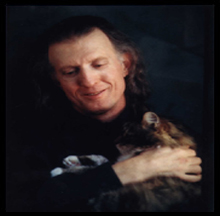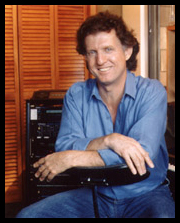 Q: What
is your musical philosophy? Q: What
is your musical philosophy?
A: My "musical
philosophy" is not really an important factor in my music. I don't
begin with some sort of conceptual description of reality and then
try to create music which conforms to that picture. The reason that
I take the trouble to compose music in the first place (and it does
involve a lot of effort) is because "philosophy," as I understand
it, doesn't get to what I most value. What I value is an open heart
and I've never been able to think my way into such a condition.
Music (and other forms of art) can assist in opening doors which
are normally shut because of the dominance of our survival mechanisms.
Mind filters out so much of our humanity. Great art, if we participate
fully in it, gives us permission to feel and creates a space in
which we can feel at a depth not ordinarily allowed.
Q: Did
you get your musical motivation from your classical guitar teacher,
Eduarco Sainz de la Maza?
A: Eduardo
was not merely a good teacher, he was a great teacher. He was certainly
a factor in my musical motivation. But I feel that I was born with
the basic impulse to do music. Even a great teacher can't supply
the basic motivation toward something as difficult as the mastery
of an instrument. He can mold things, but the student has to already
love it enough to persist regardless of the cost.
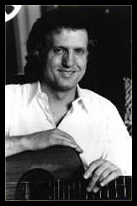 Q:
What are your
musical influences? Q:
What are your
musical influences?
A: The most
important influence throughout my career, both as performer and
composer, is Western, classical music of the last five centuries.
As a guitarist, I concentrated on 18th, 19th, and 20th century music
and as a lutenist, I specialized in the 16th and 17th centuries.
As a listener, of course, I've covered a lot of ground, from traditional
Indian music to folk music from all over the world, to 20th century
avant-garde music and popular music of our own time. There is a
great deal of recorded music of all kinds available these days and
most contemporary composers have been influenced by that diversity.
My harmonic language, however, was basically intact in the Renaissance.
Q: Did
you have a vision of success when you were growing up?
A: In our
culture, "success" seems to mean the accumulation of wealth and
in that sense, I've never had a vision of success. As a child and
adolescent, "making money" always struck me as a very mysterious
and unattractive affair and I wanted nothing to do with it. It seems
to me that if your primary interest is to make a lot of money and
accumulate the goods of life, then music or art is a very poor career
choice. The chances of success (in that sense) are slim.
For an artist,
the criteria of success is different. He or she wants the art to
"succeed." A real artist loves what he makes more than he cares
about what it may bring back to him. If you love what you make,
you have to work it until it is beautiful, until it succeeds, in
other words. When I was a performer I wanted the performance to
succeed, so I played as if my life depended on it. As a composer
I want my music to succeed, to be beautiful, and therefore useful
to myself and others. So I struggle with it until its right.
Q: Tell
us about your recording studio, and the type of technical equipment
you use. Would you consider your studio "state-of-the-art"?
A: I
have a 16-track tape recorder, an 8-track digital hard-disc recorder
(Protools), 2 computer systems, several good reverbs, a very clean
mixing board, the usual signal processing gear, the usual assemblage
of 10 or so synthesizers and samplers, a great monitor system, miles
of good wire, and an acoustically-treated room. Most of it would
be considered state-of-the-art, although it is certainly not as
extensive or as expensive as many commercial installations. But
it is tailored exactly to my needs and since Nothing Above My Shoulders But the Evening,
I've felt like I've been getting something like audiophile results.
I should
add that this kind of description of the technical side of my work
can be misleading. Many people have gotten the impression that I'm
an "electronic" composer, that I use only synthesizers to create
the sounds on my recordings. I do find synthesizers very useful
and effective for certain kinds of sounds and occasionally I have
produced purely "electronic" pieces (Celestial Soda Pop
is an example), but in general, my pieces involve a combination
of acoustic instruments (especially on melodic lines) and synthesized
or sampled sounds. Over the last 10 years, I have used more and
more acoustic instruments (normally performed by members of the
San Francisco Orchestra). In fact, in Nothing Above My Shoulders But the Evening
the acoustic element became dominant.
Childhood
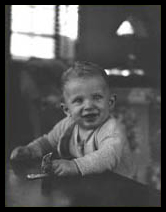 |
|
Q: Where
were you born?
A: "Although
born in Utah, I was raised in West Texas, where my father
was a lawyer and my mother, an artist. I was the second of
four children, and the family was fairly ordinary and very
stable. Both my mother and my older brother were classical
pianists and I began studying piano at the age of 5 or 6."
|
Early training. Ray's classical training began very early
with the piano. "When I turned 12, I asked my parents for a guitar
(classical, of course) and shortly thereafter, I heard a recording
of Adr s Segovia and was so moved (moved to tears in fact)
that I knew what my life was going to be about."
Ray continues:
"When I was a teenager, I wanted to be a great guitarist, a virtuoso,
an impeccable soloist in other words; not because I wanted to be
famous, but rather because the classical guitar seemed so beautiful
to me that I couldn't stay away from it."
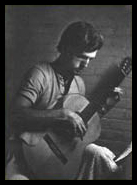
Playing the guitar |
Training in Spain.
At 18, Ray moved to Barcelona to study
guitar with Eduardo Sainz de la Maza. "I studied
classical guitar with Eduardo Sainz de la Maza
in Barcelona for three years in the 60's. I was 18 when I first
went to Spain — I had been through a year of college and was
dissatisfied with my philosophy and psychology courses and had finally
made up my mind about what I wanted to do".
"Eduardo
was not merely a good teacher, he was a great teacher. I practiced
8 hours a day, saw him twice a week, and I covered a lot of ground
in those three years. He was also a composer and I became increasingly
interested in composition. I left Spain to return to the University
of Texas in order to study composition and music theory." At age
21, Ray returned to Austin, where he spent the next three years
studying composition at the University of Texas, and composing symphonic
and chamber music, some of which was performed by the Dallas Symphony
Orchestra.
At the University of Texas. At the University of Texas he
was invited to join a group of Madrigal singers who needed a lutenist.
Ray learned to play the lute within a matter of months. "I took
up the lute 'accidentally', so to speak. When I returned to the
University of Texas from Spain to study composition I learned that
I had to satisfy a requirement for ensemble performance, which meant
playing in a band or orchestra, or singing in the choir. I didn't
want to do any of those things. Then I found out that the Madrigal
Singers (a small vocal ensemble which specialized in early music)
happened to have a lute (gathering dust in a closet) and it occurred
to me to make a deal: I would learn to play the lute and would perform
with the Madrigal Singers and would thereby satisfy the ensemble
requirement. That's how it began. But then I discovered how much
beautiful music there was from that period and I was hooked."
With the Renaissance Quartet in New York. Ray's growing
expertise with the lute earned him a second invitation, this time
from the Renaissance Quartet. He moved to New York City where he
spent the next seven years performing with the quartet and other
"Early Music" groups that were at the core of New York City's revival
of Medieval, Renaissance, and Baroque music. Some of this time was
spent in Provincetown, Cape Cod, where many of these groups would
play during the summers.
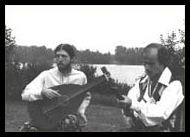
Performing on the lute with
an Early Music group in Maine
|
"The time
I spent as a part of the early music scene in New York City in the
late 60's and 70's was very valuable to me for several reasons.
Prior to that time I was primarily a soloist. As a member of the
Renaissance Quartet I had to learn how to play with other musicians,
and this involved listening and responding to what I heard. I was
fortunate to be able to work with some of the best musicians in
the country, and as I got better as an ensemble player I discovered
that performing chamber music was both more satisfying and more
demanding than my efforts as a soloist."
|
"The
most exhilarating experiences I've had as a performer were
in that context: playing with a few other great musicians
whom I had gotten to know through years of work, in a situation
where we were completely 'on' and sensitive to each other,
and the audience was totally absorbed. With discipline, freedom
and spontaneity become possible, and sometimes a 'cycle of
energy' was created around the performers, music, and audience
that was really remarkable — so much so that I was often
unable to sleep until dawn after some performances."
|
|
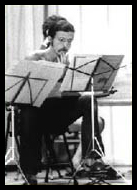
Another Early Music group in Provincetown, Cape Cod |
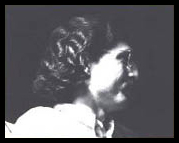
Performing in New York |
Spiritual and creative growth. Ray eventually
moved to a 125-acre farm in Maine, traveling around the country
for performances. This seemingly idyllic situation eventually precipitated
a profound "personal and spiritual crisis" in which he dropped all
the trappings of his musical career and set out for California,
where he began a period of intense study and spiritual growth with
his Spiritual Teacher, Bhagavan Adi Da Samraj. (He
has been a student since 1974.) Ray's presumption was that his musical
career was over, and was somehow incompatible with spiritual life.
But, over the years, Adi Da made it clear to Ray that this
was not the case; that, in fact, music was Ray's "sadhana" (spiritual
practice). Adi Da even suggested that Ray begin composing again,
something that Ray hadn't even considered doing since his college
days.
With renewed
awareness and focus Ray immersed himself in his creative work again.
"For reasons which I don't understand, I became compelled to create
my own music and to begin an entirely new career. I never felt 'ambitious'
relative to composing. I simply saw that if I didn't do it, I would
be wasting my life."
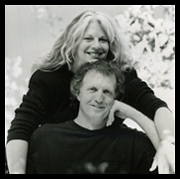
Ray and Kathleen Lynch |
Who Is Kathleen?
Ray's album, Deep Breakfast, contains a track titled "Kathleen's Song". "Kathleen"
is Kathleen Lynch. Ray and Kathleen have been married 49 years in August of 2025.
Who Is Segovia?
(from Kathleen Lynch):
"Segovia
was a Maine Coon cat who naturally passed away at the wonderful
age of 23 years. He was our beloved companion and died gently
in my arms. Segovia had no fear whatsoever he just lifted his little
head back, raised his paws towards the sky and surrendered to what
is greater than us all. At his death we placed him in our meditation
hall and laid him out on a beautiful deep purple towel with flowers
and candles all around him. We held a 3 day vigil and many of Segovia's
human friends came by and sat in our hall and we all told him how
much we loved and valued our relationship with him. It was a potent
goodbye from all who loved him.
Segovia
resembled a raccoon, was quite large, extremely relational, and
highly intelligent. He'd greet you when you entered the house (if
he liked you) by sitting in front of you and stretching out his
right front paw waiting to be petted. He loved to eat and when he
died we had a burial ceremony on our land for him and buried him
with his food bowl.
Segovia
liked to participate in whatever you were doing at the time. As
you can see from the first two photos, Ray was having some new photographs
taken at home, and Segovia jumped up on his lap to be a part of
it. He was an esteemed member of our household for over 23 years
and left a wound in our hearts when he passed. Every year on the
anniversary of his passing we do a little ceremony in remembrance
of the love and happiness he brought into our lives. Our spiritual
teacher once said:
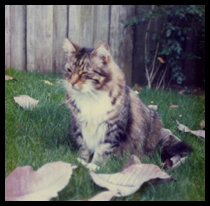 |
|
|
| |
At
Heart All are One |
| |
|



|
![]()
